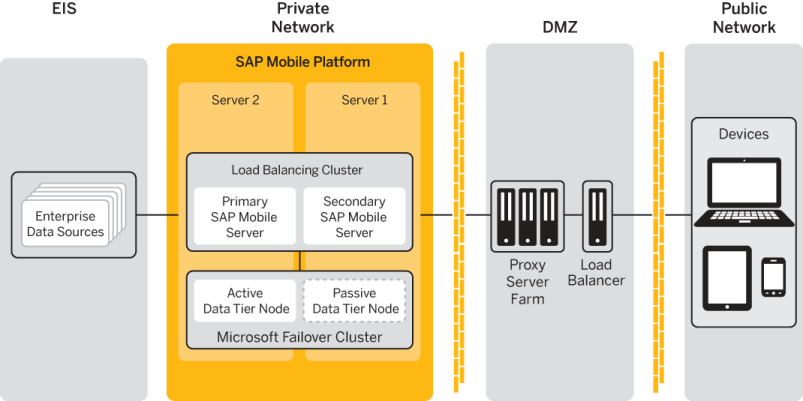Placing one data tier and one SAP Mobile Server node, installed as an application server, on each of two physical servers, is a modification of the standard Microsoft Failover Cluster. This is the minimum hardware configuration that ensures there is no single point of failure in the system.
Microsoft Failover Cluster on Shared Hosts


Summary of Microsoft Failover Cluster architecture on shared hosts:
- Resembles two single-server installations, each with an SAP Mobile Server node and a data tier installed on a single server. However, the data tiers are also incorporated in a Microsoft Failover Cluster, so that if the active data tier node fails, the passive data tier node becomes active and database support continues uninterrupted.
- Consists of two data tiers installed in a Microsoft Failover Cluster support the SAP Mobile Server nodes. If the active data tier node fails, the passive data tier node becomes active and database support continues uninterrupted.
- A proxy server farm can optionally provide enhanced load balancing for distributing requests to the two SAP Mobile Server nodes, but if you select the shared host configuration because of cost considerations, you may also want to omit proxy servers.
- A hardware load balancer can optimizes the performance of a proxy server farm, if one is present.
| Consideration | Details |
|---|---|
| Recommended for |
|
| Degree of collocation | Maximum collocation possible without a single point of failure. |
| Not recommended for | High-volume production environments. |
| Worksheet to complete | Install MS Failover Cluster worksheet. See Completing Installation Worksheets. |
| Installation procedure used | Installing SAP Mobile Server with a Microsoft Failover Cluster with Shared Hosts in Installation Guide for Runtime. |
| Limitations |
|
| Benefits |
|